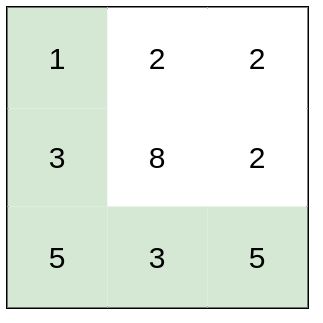LeetCode解法汇总1631. 最小体力消耗路径
目录链接:
力扣编程题-解法汇总_分享+记录-CSDN博客
GitHub同步刷题项目:
https://github.com/September26/java-algorithms
原题链接:
力扣(LeetCode)官网 - 全球极客挚爱的技术成长平台
描述:
你准备参加一场远足活动。给你一个二维 rows x columns 的地图 heights ,其中 heights[row][col] 表示格子 (row, col) 的高度。一开始你在最左上角的格子 (0, 0) ,且你希望去最右下角的格子 (rows-1, columns-1) (注意下标从 0 开始编号)。你每次可以往 上,下,左,右 四个方向之一移动,你想要找到耗费 体力 最小的一条路径。
一条路径耗费的 体力值 是路径上相邻格子之间 高度差绝对值 的 最大值 决定的。
请你返回从左上角走到右下角的最小 体力消耗值 。
示例 1:
输入:heights = [[1,2,2],[3,8,2],[5,3,5]] 输出:2 解释:路径 [1,3,5,3,5] 连续格子的差值绝对值最大为 2 。 这条路径比路径 [1,2,2,2,5] 更优,因为另一条路径差值最大值为 3 。
示例 2:
输入:heights = [[1,2,3],[3,8,4],[5,3,5]] 输出:1 解释:路径 [1,2,3,4,5] 的相邻格子差值绝对值最大为 1 ,比路径 [1,3,5,3,5] 更优。
示例 3:
输入:heights = [[1,2,1,1,1],[1,2,1,2,1],[1,2,1,2,1],[1,2,1,2,1],[1,1,1,2,1]] 输出:0 解释:上图所示路径不需要消耗任何体力。
提示:
rows == heights.lengthcolumns == heights[i].length1 <= rows, columns <= 1001 <= heights[i][j] <= 106
解题思路:
典型的贪心算法。构建一个priority_queue队列,队列中排序靠前的是差值较小的。队列中的位置,代表是贪心算法还未遍历到的额位置,如果遍历到某个位置,则把对应位置设置为差值,比如dp[y][x]=10这样。
然后选择从这个位置可以到达到的所有位置(如果已经达到过则跳过,因为该位置已经不属于最优解了),并且计算出差值,加入到队列中。直到遍历到终点结束。
代码:
bool cmp(pair> &a, pair> &b)
{
return a.first > b.first;
}
class Solution {
private:
static constexpr int forwards[4][2] = {{-1, 0}, {1, 0}, {0, -1}, {0, 1}};
public:
bool getMinHeight(int fx, int fy, int x, int y, vector> &dp, vector> &heights)
{
if (x < 0 || x == heights[0].size())
{
return false;
}
if (y < 0 || y == heights.size())
{
return false;
}
if (dp[y][x] >= 0)
{
return false;
}
return true;
}
int minimumEffortPath(vector> &heights)
{
int ySize = heights.size();
int xSize = heights[0].size();
vector> dp(ySize);
for (int i = 0; i < ySize; i++)
{
for (int j = 0; j < xSize; j++)
{
dp[i].push_back(-1);
}
}
// 使用函数指针作为比较函数
priority_queue>, vector>>, decltype(&cmp)> queue(cmp);
queue.push({0, {0, 0}});
dp[0][0] = 0;
vector> forwards = {{-1, 0}, {1, 0}, {0, -1}, {0, 1}};
while (!queue.empty())
{
pair> top = queue.top();
int x = top.second.first;
int y = top.second.second;
int value = top.first;
dp[y][x] = top.first;
queue.pop();
if (x == xSize - 1 && y == ySize - 1)
{
break;
}
if (x == 2 && y == 1)
{
cout << "1" << endl;
}
for (vector forward : forwards)
{
int newX = x + forward[0];
int newY = y + forward[1];
if (getMinHeight(x, y, newX, newY, dp, heights))
{
pair> nextNode = make_pair(max(value, abs(heights[newY][newX] - heights[y][x])), make_pair(newX, newY));
queue.push(nextNode);
}
}
}
return dp[ySize - 1][xSize - 1];
}
};


